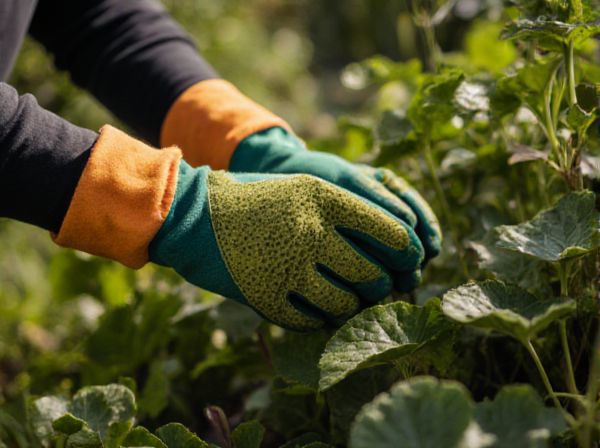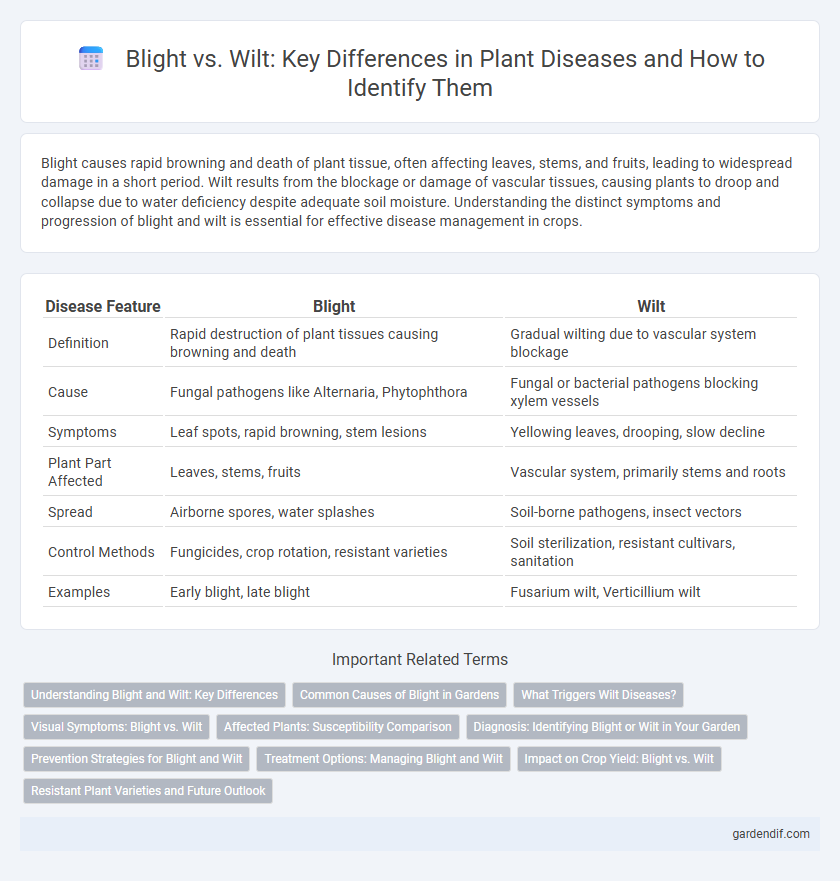
Blight vs Wilt Illustration
Blight causes rapid browning and death of plant tissue, often affecting leaves, stems, and fruits, leading to widespread damage in a short period. Wilt results from the blockage or damage of vascular tissues, causing plants to droop and collapse due to water deficiency despite adequate soil moisture. Understanding the distinct symptoms and progression of blight and wilt is essential for effective disease management in crops.
Table of Comparison
| Disease Feature | Blight | Wilt |
|---|---|---|
| Definition | Rapid destruction of plant tissues causing browning and death | Gradual wilting due to vascular system blockage |
| Cause | Fungal pathogens like Alternaria, Phytophthora | Fungal or bacterial pathogens blocking xylem vessels |
| Symptoms | Leaf spots, rapid browning, stem lesions | Yellowing leaves, drooping, slow decline |
| Plant Part Affected | Leaves, stems, fruits | Vascular system, primarily stems and roots |
| Spread | Airborne spores, water splashes | Soil-borne pathogens, insect vectors |
| Control Methods | Fungicides, crop rotation, resistant varieties | Soil sterilization, resistant cultivars, sanitation |
| Examples | Early blight, late blight | Fusarium wilt, Verticillium wilt |
Understanding Blight and Wilt: Key Differences
Blight primarily causes rapid and extensive tissue death on leaves, stems, or flowers, resulting in large, dark, and often sunken lesions. Wilt affects the vascular system of plants, leading to the blockage of water transport, causing leaves to droop, yellow, and eventually die. Recognizing these differences in symptom development and plant tissue affected is crucial for accurate diagnosis and effective disease management.
Common Causes of Blight in Gardens
Blight in gardens is commonly caused by fungal pathogens such as Alternaria, Phytophthora, and Botrytis, which thrive in warm, moist conditions. Bacterial blight, particularly caused by Xanthomonas species, also frequently affects plants by rapidly damaging leaves, stems, and fruits. In contrast to wilt, blight often results from environmental factors that promote pathogen proliferation, including excessive humidity and poor air circulation.
What Triggers Wilt Diseases?
Wilt diseases are primarily triggered by soil-borne pathogens such as fungi, bacteria, and nematodes that invade plant vascular systems, blocking water transport. Environmental stresses like drought and root damage can exacerbate these infections, promoting rapid spread and severity. Key agents include Fusarium oxysporum, Verticillium spp., and Ralstonia solanacearum, which cause systemic wilting by obstructing xylem vessels.
Visual Symptoms: Blight vs. Wilt
Blight symptoms typically include rapid browning and death of leaves, stems, or flowers, often displaying large, dark, water-soaked lesions that expand quickly, leading to extensive tissue collapse. Wilt symptoms manifest as gradual yellowing and drooping of leaves, followed by a loss of plant turgor, usually starting from the lower leaves and progressing upward as vascular tissue becomes clogged or damaged. Blight causes surface necrosis and rapid tissue death, while wilt results from impaired water transport within the plant's vascular system.
Affected Plants: Susceptibility Comparison
Blight commonly affects a wide range of plants including tomatoes, potatoes, and beans, causing rapid tissue death and leaf discoloration. Wilt typically targets vascular systems in plants such as cotton, tomatoes, and bananas, leading to drooping and eventual plant death. Susceptibility varies with blight favoring humid conditions that promote fungal growth, while wilt often results from bacterial or fungal infections blocking water conduction.
Diagnosis: Identifying Blight or Wilt in Your Garden
Blight symptoms typically include rapid leaf discoloration and tissue death, often spreading quickly across plants, while wilt is characterized by drooping leaves and stems caused by vascular system blockage. Diagnosing blight involves checking for dark lesions and fungal growth on leaves and stems, whereas wilt diagnosis requires inspecting roots and stems for signs of rot or pathogen invasion. Accurate identification relies on observing symptom patterns, performing laboratory testing for fungal or bacterial pathogens, and assessing environmental conditions contributing to disease development.
Prevention Strategies for Blight and Wilt
Effective prevention strategies for blight include crop rotation, resistant plant varieties, and timely application of fungicides to reduce fungal spore buildup. Wilt prevention involves using disease-free seeds, soil solarization to eliminate pathogens, and maintaining proper irrigation to avoid water stress and root damage. Implementing good sanitation practices by removing infected plant debris limits the spread of both blight and wilt diseases.
Treatment Options: Managing Blight and Wilt
Effective treatment options for managing blight include the application of fungicides such as chlorothalonil or copper-based compounds, along with removing and destroying infected plant debris to limit disease spread. Wilt diseases often require soil solarization, crop rotation with resistant varieties, and targeted use of biological control agents like Trichoderma species to suppress pathogen activity. Combining cultural practices with chemical or biological treatments enhances disease control and prevents recurrence in both blight and wilt cases.
Impact on Crop Yield: Blight vs. Wilt
Blight causes rapid and extensive damage to leaves, stems, and fruits, leading to significant defoliation and fruit rot, which drastically reduces crop yield in a short period. Wilt primarily affects the vascular system, disrupting water transport and causing gradual plant decline, often resulting in moderate to severe yield loss over time. Both diseases critically impact productivity but differ in the progression and specific plant tissues they target.
Resistant Plant Varieties and Future Outlook
Resistant plant varieties for blight often include genetically engineered tomatoes and potatoes with enhanced resistance genes like RB and Ph-3, reducing losses caused by Phytophthora infestans and other pathogens. Wilt-resistant cultivars, especially in crops like cotton and tomatoes, frequently possess traits that combat Fusarium and Verticillium species, improving plant vascular health and disease tolerance. Future outlook emphasizes advances in CRISPR technology and marker-assisted selection to develop multi-disease resistant cultivars, aiming to ensure sustainable crop production despite evolving pathogen strains.
Blight vs Wilt Infographic

 gardendif.com
gardendif.com